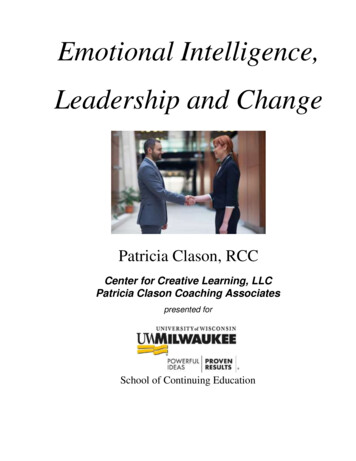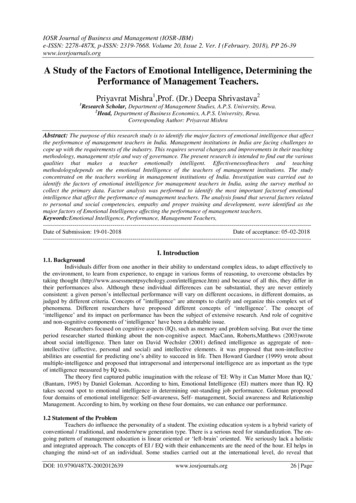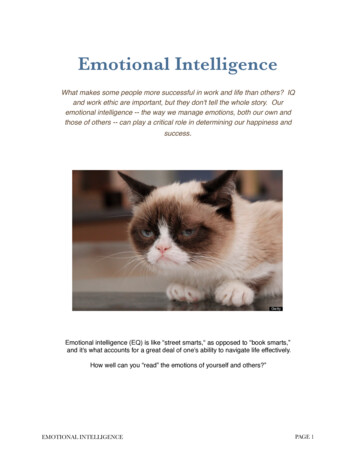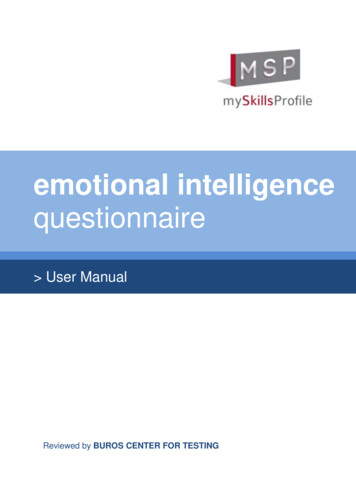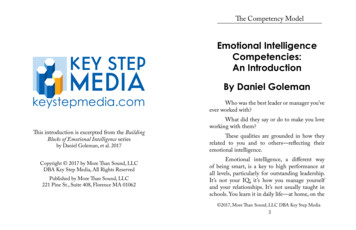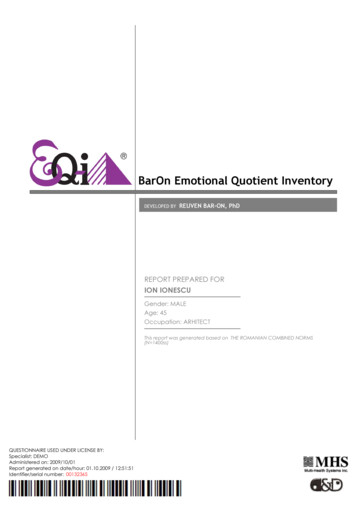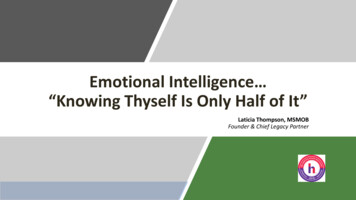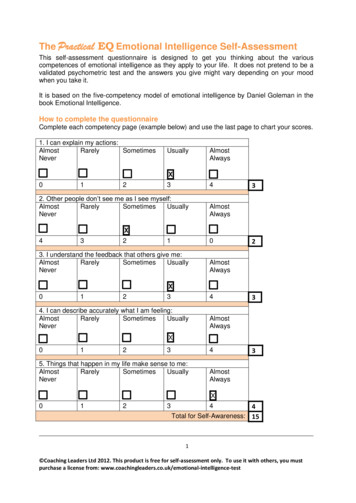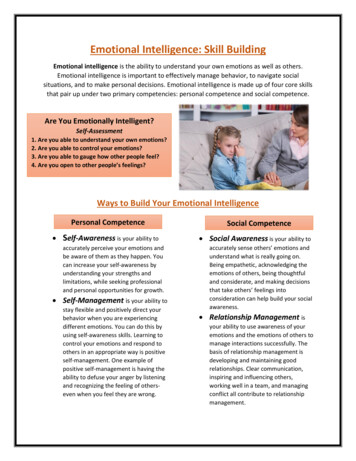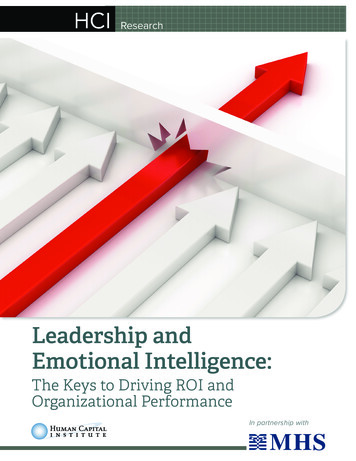
Transcription
HCIResearchLeadership andEmotional Intelligence:The Keys to Driving ROI andOrganizational PerformanceIn partnership with
Leadership and Emotional Intelligence: The Keys to Driving ROI and Organizational PerformanceTable of ContentsExecutive Summary.1Key Research Insights.3About this Research.4Definition of Key Terms.5The Breadth and Depth of Emotional Intelligence.5The State of Leadership Development.7Use of Emotional Intelligence in Organizations.13Impact of Emotional Intelligence on Leadership Development.15Conclusions & Recommendations.19Appendix A: About the Research Partners.21Appendix B: Respondent Demographics.22Appendix C: Works Cited.24iiiCopyright 2013 Human Capital Institute. All rights reserved.
Leadership and Emotional Intelligence: The Keys to Driving ROI and Organizational PerformanceLeadership and EmotionalIntelligence:The Keys to Driving ROI andOrganizational PerformanceExecutive SummaryEmotional Intelligence, popularly referred to as EI or Emotional Quotient (EQ), hasbecome a prolific topic within corporate leadership development. This originalresearch by the Human Capital Institute (HCI) and Multi-Health Systems (MHS) usesinsights from organizational leaders surveyed in the spring of 2013 to addressthe usefulness and application of Emotional Intelligence as a factor in developingleaders, shaping organizational culture, and ultimately impacting an organization’sfinancial performance.The corporate world has long recognized that the greatest and most effectiveleaders offer more than traditional intelligence. Indeed, countless “smart” leadershave fallen from grace in recent years, during a time when maintaining composureand keeping emotional reactions in check has never been more publicized. Whenit comes to building strong leaders, organizations are now turning to the concept ofEmotional Intelligence to help give leaders a new type of intelligence edge aboveand beyond technical aptitudes.We argue that Emotional Intelligence is more than an amorphous concept related to“playing well with others.” It is made up of a specific set of observable and measurableemotional and social skills that impact the way people perceive and expressthemselves, develop and maintain social relationships, cope with challenges, anduse emotional information in an effective and meaningful way. In fact, the process/mechanism by which EI impacts an organization and its bottom line is through itsrole in creating a high-performance culture. As Roger Pearman, Founder and CEO1Copyright 2013 Human Capital Institute. All rights reserved.
Leadership and Emotional Intelligence: The Keys to Driving ROI and Organizational Performanceof Leadership Performance Systems, said, “What builds great and sustainableorganizations are leaders with a high degree of business acumen—specific skills,planning and control—and Emotional Intelligence—methods to keep people motivatedand engaged. Leaders who have a sensitivity to relationships and do a good job ofbuilding relationships have something beyond business skills that help organizationssucceed. They have highly developed, emotionally-intelligent behaviors.”Emotional Intelligence Competenciesohi nalpsytyismNINBELELNAL & SO CIAL FUIONCTOINGibpNALOpt imalImEIRSEPINTERWceanlerS t r e s s ToRMANCEP SRe-BCLLDE AM GWEIONrspe nsretI n atiothRelpasE m ponseal RSociPERFOilityMENGdeF l ex i bINWBEr essionl Exponaessot it i ve nserdencepenAsEmotionalIntelligencerool ble mvinitgu l y TestisengControlOTL-nEmEmo t i onalwa r e n e se l f- AsELS e l f- Re g a r dt uae l f- A c l i z a t i oSK I SI O NNGEMGWSISNINESSIONEXPRLFSETInS T R E E L L -B EINMANA G S SE& SOCIAL right 2011 Multi-Health Systems Inc. All rights reserved.Based on the original BarOn EQ-i authored by Reuven Bar-On, copyright 1997.2Copyright 2013 Human Capital Institute. All rights reserved.
Leadership and Emotional Intelligence: The Keys to Driving ROI and Organizational PerformanceIn this report, we examine the state of Leadership Development in general, concludingthat improvements are sorely desired by senior leaders. The leadership competenciesidentified as most important by managers and individual contributors within theorganization are examined, and the current applications of Emotional Intelligenceare explored. Finally, we hypothesize—and, indeed, find—that organizationaldevelopment practices that utilize Emotional Intelligence result in measurableachievement, success in leadership development, and—ultimately—enhancedfinancial performance. Specifically, these strides in leadership development produce ahigh-performance culture that, along with other best practices from diverse disciplinesin an organization, positively impact financial performance. We conclude with specificways in which HR leaders can most effectively integrate Emotional Intelligenceas part of a robust leadership development program. Most notably, these includeincreased emphasis on measuring Emotional Intelligence through assessments, andefficiently using that information to inform leadership training and skills-development.Key Research Insights L eadership development efforts need immediate improvement. More than halfof survey respondents think the current Leadership Development efforts at theirorganizations are less than effective. Individual contributors and managers disagree about what leadership behaviorsare most important in today’s environment. While managers feel coaching skills arenot very important, nearly twice as many individual contributors surveyed disagree.Adaptability, problem solving and stress tolerance are also behaviors with the largestgaps in perceived importance between individual contributors and managers. However, communication, interpersonal skills and self-awareness are all behaviorsthat both individual contributors and managers want to see more of in the future.Individual contributors want to see their leaders practice these behaviors more frequently,and managers report that they will be even more important in the next 2-5 years. Spending more on leadership development results in higher revenue. Organizationsthat spend more than 31% of their annual Training & Development budgets onLeadership Development are 12% more likely to report increased revenue. M ore than 75% of respondents use at least one type of leadership developmentmethod in their organization. Nearly half of organizations report that EI is atopic of Training & Development courses, as well as an objective for leadershipcoaching. E motional Intelligence assessments are an inexpensive, simple and veryeffective way to impact leadership development. Sixty percent of those whouse Emotional Intelligence assessments say they are effective or very effective.Equally efficient methods of development include executive coaching, jobrotations, and global assignments.3Copyright 2013 Human Capital Institute. All rights reserved.
Leadership and Emotional Intelligence: The Keys to Driving ROI and Organizational Performance T ime and support are critical to implementing leadership developmentinitiatives and yet, are lacking in organizations. Executives fail to supportleadership development initiatives, and limited time also keeps it from becomingan organizational priority. E motional Intelligence remains an untapped resource for nearly 1 in 3organizations. Twenty-nine percent of survey respondents report that EmotionalIntelligence is not a focus for their organizations. O rganizations that value and widely use Emotional Intelligence are 3.2xmore effective at leadership development. There is a 31% gap in leadershipdevelopment effectiveness between organizations where EI is valued, versusthose in which it is not. O rganizations that integrate Emotional Intelligence in at least two differentways are 25% more likely to have extremely effective leadership development.In contrast, only 15% of organizations that do not widely implement EmotionalIntelligence report effective leadership development. I ncorporating Emotional Intelligence as part of leadership coaching supportshigher performance. When organizations incorporate Emotional Intelligence inleadership coaching, they are 36% more likely to report effective EI performance. U sing assessments to track or measure Emotional Intelligence helps supportpositive revenue growth rates. While many factors impact revenue growth,organizations that measure EI are 16% more likely to report positive revenue growth.About this ResearchThis research study is a collaborative effort between the Human Capital Institute(HCI) and Multi-Health Systems (MHS). An online survey was conducted fromApril - May 2013 with 784 respondents representing more than 500 organizationsworldwide. These research findings form the basis of this report and aresummarized below. In addition, information and quotes from in-depth qualitativeinterviews with subject-matter experts and relevant secondary sources, includingwhite papers, articles, books and case studies help inform our findings. Among thepractitioners and thought leaders interviewed especially for this report: B ob Anderson, CEO, 1Hero Sports D rew Bird, Principal, Clearpoint EQ R oger Pearman, Founder and CEO, Leadership Performance Systems D r. Margareta Sjölund, Chief Psychologist and Founder, Kandidata Asia D r. Steven Stein, Chief Executive Officer, MHS4Copyright 2013 Human Capital Institute. All rights reserved.
Leadership and Emotional Intelligence: The Keys to Driving ROI and Organizational PerformanceDefinition of Key TermsLeadership DevelopmentThe implementation of activities that enhance the quality of leadership for anindividual or within an organization, such as workshops, executive coaching, jobrotations or assessments.Emotional IntelligenceAlso referred to as EI or EQ, refers to a set of emotional and social skills thatinfluence the way individual contributors perceive and express themselves,develop and maintain social relationships, cope with challenges, and useemotional information in an effective and meaningful way.Financial PerformanceIndicators of an organization’s business results, such as revenue, expenses andprofit. In the survey research reported here, financial performance is measured asan organization’s revenue growth rate in the past fiscal year.“Executives and managerswho have betterrelationships with peopleare exposed to moreinformation and morethorough information. Asa result, they can makebetter informed decisions.When you reframe EQand you move beyondthe hype of the phrase,you have to ask thenaysayers, do you reallythink that relationshipsare unimportant? Peoplewant to be around,work for, and walkthrough hell for peoplewho give them regard,respect, recognition, andappreciation.”—Roger Pearman,Founder and CEO,Leadership PerformanceSystems5High-Performance CultureAn organizational culture in which individual contributors and managers act insystematic ways that encourage positive financial performance. Well-developedEmotional Intelligence is a critical part of a high-performance culture.The Breadth and Depth of Emotional IntelligenceAs early as the 1920s, psychologists proposed the existence of an emotional facet ofintelligence. American psychologist Edward Thorndike called it “social intelligence,”or the ability to get along with others. In 1983, Howard Gardner at Harvard Universitypublished a groundbreaking work that paved the way for modern research intomultiple types of intelligences. Around this time, and into the early 1990s, researcherssuch as Reuven Bar-On, Jack Mayer, Peter Salovey, and David Caruso were busydeveloping and testing scientific measures of Emotional Intelligence.After the release of Daniel Goleman’s book Emotional Intelligence: Why It Can MatterMore Than IQ in 1995, the principles of emotional and social intelligence became moremainstream and are now widely recognized as being an important factor in a person’ssuccess.1 Alongside this now-popular construct is the demand for a valid and reliableway to measure EI: helping to engrain measurable development in the individualwhile also creating tangible ties to organizational outcomes. EI is no longer simply “agood thing to know about.” As we explore in this study, EI measures have embeddedthemselves into many organizational practices, including leadership development.Dr. Margareta Sjölund from Kandidata Asia explains one of the prominent reasonsfor this shift and new approach. “Leaders today have to do more with less.Copyright 2013 Human Capital Institute. All rights reserved.
Leadership and Emotional Intelligence: The Keys to Driving ROI and Organizational PerformanceThey need to streamline information and processes in the face of increasedcommunication and outsourced talent,” she said. “As a leader, you have to makepeople want to work with you. Understanding people, recognizing their wantsand needs and capitalizing on that information effectively requires EmotionalIntelligence, no matter where in the world you are. The necessity of humanconnection is universal.”“The necessity of humanFurther scientific and anecdotal evidenceabout the significance and rationaleconnection is universal.of using Emotional Intelligence inorganizations is abundant. One recent Inc. Magazine article states “If leadershipis mainly engaged in human relations, then leadership, at its core, is largely aboutemotions,” noting that Chip Conley of Joie de Vivre Hotels goes so far as to referto the CEO as the “Chief Emotions Officer.”2 Another author advises in Forbesthat leaders must become more emotionally intelligent “to be more effective andefficient at maximizing outcomes and desired results,”3 and an OrganizationalDynamics article states that “ .To be an effective leader, manager or professional,a person needs to understand and skillfully manage his emotions appropriatelybased on each person or situation and understand the emotional cues of others inorder to effectively interact with others.”4”Developing the next generation of corporate leaders is a key concern for HRexecutives today given the tenuous upturn in the economy and increasingdepartures of organizational leaders. In fact, after retaining and rewarding topemployees, a 2012 Society for Human Resources Management survey foundthe second-greatest concern facing HR executives is the development of nextgeneration leaders.5 With the generational exit of the baby boomers, steep learningcurves for incoming executives, and tight Training & Development budgets, gettingleadership development “right” is essential. “More than any other time in history,we have more generations and cultures having to work together. A managercould easily have three or four ethnicities and generations on their team, andunderstanding the needs of each of those groups requires [a high degree of]Emotional Intelligence,” Roger Pearman from Leadership Performance Systemssaid. “You simply cannot be successful in today’s environment without having theskills and understanding to communicate effectively cross-generationally andcross-culturally. Working with and through people is critical.”Of the many topic areas leadership development can address, how can HRexecutives be sure that Emotional Intelligence isn’t just another “flavor ofthe month,” and that it will have a real, measurable business impact? Thisresearch addresses that very question, along with the corollary challenge ofimplementation—how can organizations incorporate Emotional Intelligenceframeworks in their development programs and methods to build a highperformance culture?6Copyright 2013 Human Capital Institute. All rights reserved.
Leadership and Emotional Intelligence: The Keys to Driving ROI and Organizational Performance—Dr. SteVen Stein, ChiefEXecutiVe Officer, MHSFig. 1: LeadershipDevelopment Spending& ROIThe State of Leadership DevelopmentAs a first step in our survey research, we focused on the current businessinvestments in leadership development and if those monies have an impact onorganizational performance. Although only a minority of respondent organizationsprioritize investment in leadershipdevelopment over other training options,nearly three quarters ofthose companies that do are experiencingrespondent organizationstangible ROI through positive financial(64%) spend only 10% orresults. Organizations that spend asignificant portion—31% or more—ofless of their Training &their Training & Development budgets ondevelopment budget onleadership development are 12% moreleadership development.likely to report increased revenue thanthose that spend less. This suggests apositive relationship between investment in Leadership Development and financialperformance. Of those organizations that are high leadership developmentspenders, 45% report 5% or higher revenue growth rates over the prior year. Bycontrast, only 33% of organizations that spend less than31% of their annual Training & Development budgetson leadership development report positiverevenue growth (see Fig. 1).45%of High LeadershipDevelopmentspendersREPORT 5% ORHIGHER REVENUEGROWTHvs.33%of Low LeadershipDevelopmentspenders712% Gap“Leadership developmentis a very strongorganizational investment.We want to have depthin our leaders, and thatis becoming increasinglymore important. Manyorganizations start outentrepreneurial with onegreat leader, but with timeand growth, having depthof skills and expertisebecomes critical.Organizations need tobe surrounded with greatleaders.”In addition to the ROI that is a resultof investment in leadershipdevelopment, it is notable thatthe majority of respondentorganizations invest less than 31%of their Training & Developmentbudgets in it. In fact, our datareveal that nearly three quartersof respondent organizations (64%)spend 10% or less of their Training &Development budget on leadershipdevelopment, and are notexperiencing the revenue growthassociated with greater investment.Figure 1 compares the impact leadership developmentspending has on an organization’s revenue growth rate.High spenders are more likely to report positive growthrates over the prior year.Copyright 2013 Human Capital Institute. All rights reserved.
Leadership and Emotional Intelligence: The Keys to Driving ROI and Organizational PerformanceThese data indicate a clear opportunity for organizations to consider increasing thebudget for leadership development. “Fiscal constraints and budgetary pressuresaffect both public and private-sector organizations,” Marie Westbrook wrote in2012. “Intelligent and innovative approaches will result in a sustainable structure forleadership development and efficient use of limited resources in the near term whilebuilding a foundation for an attainable “future state” for leadership development [ ]well-executed and relevant leadership development programs focus attention onthe relationship across climate, culture, performance, and mission.”6In addition to examining the financial impact of leadership development, it isimportant to identify and consider the satisfaction levels respondents have aboutthe current leadership development in their organizations. The financial impact ofleadership development is not always visible to every employee, so it’s important togauge levels of satisfaction, as they often translate to internal support. If a trainingprogram targets the most coveted leadership skills and is successful, that messageis often disseminated throughout an organization faster by word of mouth thanthrough any formal efforts.Our data show that half of survey respondents only rate their organizations’leadership development efforts as “somewhat effective,” indicating obvious roomfor improvement (see Fig. 2). More striking is that 1 in 4 report their organizations’leadership development as ineffective and in critical need of repair. When we lookexclusively at responses from managers, the results are equally dire with only 7% ofmanagerial respondents who rate their organizations’ leadership development as“very effective.” The unequivocal message from most HR practitioners—individualcontributors and managers alike—is that leadership development efforts todayare in need of immediate improvement.Fig. 2: LeadershipDevelopment EffectivenessExtremely/very effective24%Somewhat effectiveIneffective51%25%out of everyreport their Leadership Development efforts are ineffectiveFigure 2 illustrates how current leadership development efforts are perceived in organizations today.8Copyright 2013 Human Capital Institute. All rights reserved.
Leadership and Emotional Intelligence: The Keys to Driving ROI and Organizational Performance“People flock toorganizations withemotionally intelligent workenvironments. We havewitnessed these kind ofcompanies grow and moveforward—even in timesof struggle. By contrast,it’s a risky proposition todisregard the impact ofEmotional Intelligence.Organizations that donot invest in EI are goingto deteriorate over time.They are going to losethe talent they have. Theyare not going to be ableto attract or retain thetalent they need, and theyare no longer going to beorganizations of the future.”—Dr. SteVen Stein, ChiefEXecutiVe Officer, MHSFig. 3: Use of LeadershipDevelopment MethodsAfter understanding the different levels of investment in and satisfaction withleadership development outlined above, we further examined what approachesto leadership development are most commonly used. Our data find that morethan 3 out of 4 organizations employ at least one type of leadership developmentmethod, suggesting that there is widespread knowledge about the importanceof developing strong leaders through a variety of learning techniques. The mostcommonly used approaches are workshops, cross-functional meetings or projects,and classroom training. Most promising is that more than one-third (37%) ofsurveyed organizations use Emotional Intelligence assessments to help inform theirleadership development programs (see Fig. 3).As the role Emotional Intelligence plays in effective leadership continues to grow,organizations would be wise to further shift their leadership development dollars ina way that supports this trend. Dr. Margareta Sjölund of Kandidata Asia remarkedon the global presence and growth of EI. “I have seen and worked with EmotionalIntelligence across three continents and more than 15 countries, and to that end, Ihave witnessed how fundamental it is to effective leadership, and the larger role itcontinues to play in the success of organizations.”Workshops80%Cross-functional meetings73%Classroom training73%Informal mentoring program67%Skills/competency assessments62%Guest speakers/seminars62%Executive coaching61%Off-site leadership retreats56%Peer group discussions53%Emotional intelligence37%Job rotations37%Formal mentoring programGlobal assignmentsOther33%24%22%Figure 3 outlines what types of leadership development methods are most commonly used withinorganizations.9Copyright 2013 Human Capital Institute. All rights reserved.
Leadership and Emotional Intelligence: The Keys to Driving ROI and Organizational PerformanceExploring the specific challenges related to developing leaders today is anothercritical question we asked. HR managers cite executive support/buy-in and limitedtime as the top barriers hindering effective leadership development (see Fig. 4). In thatvein, it is worth noting that leadership development methods require a commitmentof time and consistency in order to be most effective, but the payoff that investmentprovides in the future is vital. Time and support are critical to implementingleadership development, but both are lacking in many organizations.Fig. 4: LeadershipDevelopment ChallengesExecutive support/buy-in22%Time dedicated to leadershipdevelopment21%12%Money/budget contraintsIdentifying/establishing criticalleadership competencies11%Choosing effective methods ofleadership development8%Attracting top talent forleadership positions8%Measurement of leadershipdevelopment (ROI)Retaining key talentIdentifying high potentials7%6%5%Figure 4 displays the top organizational challenges to developing leaders today.The gaps in executive championship and buy-in exist at precisely the time that suchsupport is urgently needed. One practitioner explored the issue today and wrote:“It wasn’t so long ago that business leaders were widely admired, evenadulated. In the 1990s they were treated like rock stars no doubt fueledby a strong economy .These days that hierarchical model has ceasedto be effective because it fails to motivate people, particularly youngergenerations. Today’s successful companies are filled with knowledgeworkers who don’t respond to hierarchical leadership.” 710Copyright 2013 Human Capital Institute. All rights reserved.
Leadership and Emotional Intelligence: The Keys to Driving ROI and Organizational PerformanceThis quote also helps surface a crucial trend in leaders today—that perhapsthey are missing something that allows them to motivate and inspire their teams.Emotionally intelligent leaders have bridged that gap successfully; they useskills like empathy, self-awareness and emotional expression to understand theunique needs of their followers and using emotions, appeal to what is individuallymotivating. In addition to the cultural and generational shifts at play, leaders anddecision makers are found throughout organizations today, not just at the top,thereby increasing the need for leadership know-how to be nurtured throughout anorganization. And, as one practitioner argues, the ultimate test of all leaders is howwell they prepare those who will take their place.8Fig. 5: Importance ofLeadership CompetenciesInterestingly, our data find that managers and individual contributors disagree aboutthe importance of specific leadership behaviors, illustrating a potentially problematicdisconnect between leaders and their followers. Most notably, individual contributorshighly value coaching skills, while managers tend to downplay them. Managers, onthe other hand, are much more likely than individual contributors are to emphasizethe importance of adaptability, problem solving and stress tolerance (see Fig. 5). ManagersAdaptability Individual contributorsGaps45%18%27%Coaching skillsProblem-solvingskills49%45%26%Stress toleranceInterpersonal 1%22%19%36%18%Impulse control27%16%9%8%26%34%8%Figure 5 compares managers’ and individual contributors’ perceptions of key leadership competencies.11Copyright 2013 Human Capital Institute. All rights reserved.
Leadership and Emotional Intelligence: The Keys to Driving ROI and Organizational PerformanceFig. 6: Important LeadershipCompetencies AmongManagers and IndividualContributorsManagerPerspectiveIndividual ContributorPerspectiveCoaching skillsAdaptabilityInterpersonalskills“In the past 20 yearsor so, there has been alot of discussion aboutEmotional Intelligence,but its importance ineffective leadership isjust now becoming muchmore broadly accepted.For a long time, peoplewere focused on skillsdevelopment—managingconflict, communicatingbetter, etc.—but theapplication of theseskills in the workplace isnot nearly as effectiveas it needs to be. Manyleaders fail to apply thetools and skills they learn.Even if they see the direct,tangible benefit, somethingis stopping them fromdoing it—and that barrieris generally associatedwith their underlyingEmotional Intelligence.”Problem-solvingskillsEmpathyFigure 6 demonstrates the top three leadership competencies identified by managers andindividual contributors.In addition to measuring the importance of specific competencies, we askedrespondents to think about the future, and determine what behaviors individualcontributors want to see leaders practice more frequently. We find that managersshare some common perspectives about what traits will become significantly moreimportant in the workplace during the next few years. Specifically, managers andindividual contributors agree that communication, interpersonal skills and selfawarene
developing and testing scientific measures of Emotional Intelligence. After the release of Daniel Goleman’s book Emotional Intelligence: Why It Can Matter More Than IQ in 1995, the principles of emotional and social intelligence became more mainstream and are now wid
